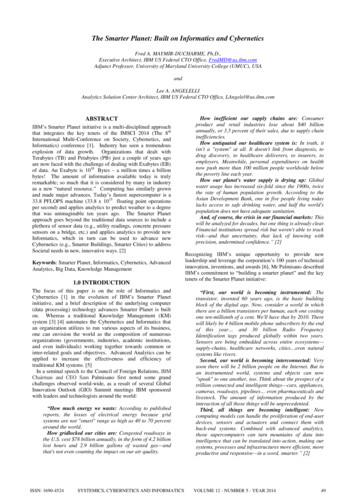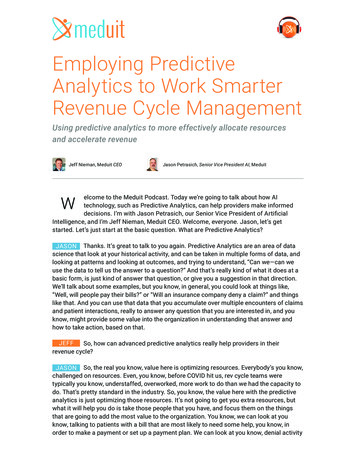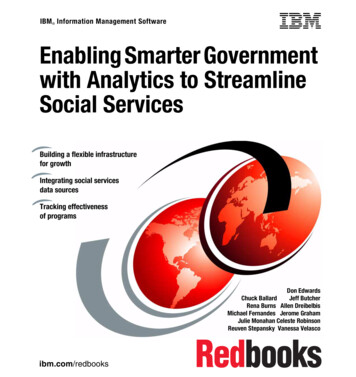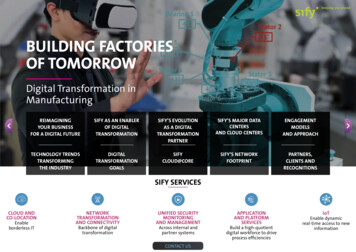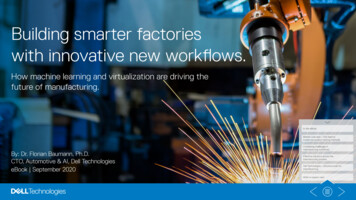
Transcription
Building smarter factorieswith innovative new workflows.How machine learning and virtualization are driving thefuture of manufacturing.By: Dr. Florian Baumann, Ph.D.CTO, Automotive & AI, Dell TechnologieseBook September 2020
The manufacturing industry finds itself at a pivotal juncture as technological innovation,coupled with changing social norms, are transforming the approach to best practices withinthe industry.Advancements in machine learning for predictive quality and predictive maintenance haveenabled the development of smart factories to enhance production quality and reach newlevels of operational efficiency. Specifically, these new smart factories reduce unplanneddowntime, increase equipment availability and improve product quality.In addition, an increased emphasis on physical distancing and a contact-free economy hasemerged to meet public health directives, challenging conventional manufacturing methods,and requiring a more innovative approach that also improves worker safety.This eBook focuses on the workloads that manufacturers can implement and leverage toenhance operations, such as testing and training, to ensure that high levels of productionquality are achieved, and adherence to changing social practices.
In this eBook:Market overview—The need tomodernize product testing methods.Combating challenges inmanufacturing workflows.Effective solutions across themanufacturing process.Dell Technologies—Solutions built formanufacturing.What to expect next.
Market overview—The need to modernize product testing methods.Manufacturing workflows have undergone theirshare of transformation over the years, incorporatingtechnological advancements, such as automation,big data, robotics, the Internet of Things (IoT) andartificial intelligence (AI). These methodologies andtools are leveraged to ensure that product qualityobjectives are met, both during and after production,as pass-fail testing traditionally occurs at every stageof manufacturing.When looking at adopting the latest manufacturingmethodologies, there are two workloads that shouldbe considered prominent focus points. The first isthe virtualization of Computer Aided Design (CAD)and Computer Aided Engineering (CAE) workloads.CAD/CAE workloads fall into the early stages ofmanufacturing during the design phase. They includeconducting finite element analysis simulations,which could consist of thermodynamics, fluiddynamics, or a variety of other types of analyses and
processes. The second workload involves building asmart factory with predictive quality and predictivemaintenance capabilities. Predictive quality involvesusing AI for ongoing testing to detect anomaliesand the likelihood of product failure before theproduct leaves the manufacturing line. Predictivemaintenance involves the use of AI to get aheadof any potential manufacturing equipment failures.The concept of predictive quality and predictivemaintenance in manufacturing workflows is the sameacross industries, whether it’s in the manufacturingof automotive parts or electronics components.In an ideal world, a manufacturing line and hardwarewould consist of brand-new technology for testingand include sensors to measure external variables,such as vibration, temperature and humidity,that may affect production quality. However, nomanufacturing line is 100 percent up to date. Manycompanies use the same machines they have reliedon for decades. Part of the challenge is identifyingthe areas where technology can be added to thesemachines to increase manufacturing intelligenceand ensure testing methods are as up to date andaccurate as possible.
Combating challenges in manufacturing workflows.Return on investment (ROI) is a critical performance measure forthe success of any business. For many manufacturers, the mosteffective way to ensure that ROI is achieved is by relying on leanmanagement principles, which focus on maximizing productivitywhile simultaneously minimizing waste within manufacturing systems.Gartner identified the “Eight Wastes of Lean Manufacturing” asdefects, overproduction, waiting, non-utilized talent, transportation,inventory, motion and over-processing.1There are several ways that manufacturers routinely combat wastein their workflows. For example, companies generally have a varietyof CAD and CAE applications they employ, depending on the devicesthey design. Additionally, a product lifecycle management tool is usedto index all parts and assemblies, as well as any associated revisionsthat are necessary. However, when leveraging a CAD or CAE toolto research an assembly process, which can consist of hundreds orthousands of individual parts, the end users encounter significantload times. The delayed load is in part due to bandwidth, and in partdue to storage performance, as a multitude of engineers attempt to
access the network simultaneously. Such network bottlenecks lead tosignificant wasted time as engineers wait to access files.Defects are another significant source of waste in manufacturingworkflows. A common challenge in manufacturing testing is thatroutine tests may be conducted at every stage of production, withthe part passing the test at each stage. When testing is complete,everything is switched on and the part now fails. It’s unknown exactlywhy the part failed. But if parts are still failing even though they arewithin the defined tolerances, it indicates there are other key factorsor variables that weren’t measured during testing. Different parametersmay need to be measured that may have been overlooked, such astemperature in the room.To combat this, machine learning, artificial intelligence and real-timeanalytics play a critical role. Robust data collection must occur ateach stage to build a model of the manufacturing line to identify orpredict when parts will fail, and then improve quality or to estimate theremaining machines’ runtime. As data is collected over time, analyticsmay be run on the data, and patterns may be identified and used topredict the likelihood of a part failing and at what stage.
Effective solutions across the manufacturing process.Virtualized CAD/CAE applicationsTo address high load times with CAD applications, VMware Horizon leverages GPUacceleration via data center processing. This enables GPUs to be timeshared across manyusers, allowing faster load times for high-end graphics, improved interaction among usersand enhanced flexibility.Deploying virtualization with CAD has proved effective by providing high-speed networking tocombat slow network traffic. It provides massive parts databases that are housed within DellEMC PowerScale in the data center. There is a dedicated 40GB network connection betweenthe servers and PowerScale within the network. Everything is virtualized on the servers, with athin client enabling very low amounts of data transferring to the engineers to make everythingrun much faster. Additionally, managing a server eliminates the need for an expensive workstationand allows for an inexpensive terminal to be shared by many users. This also allows for improvedsynchronization and security. Data doesn’t leave the data center, because everything is keptthere, with only the graphical interface being sent across the network. All that’s required is akeyboard and a display. The USB ports are disabled, with no data physically on the remote device.Virtualization of CAD and CAE workloads allows more efficient use of engineering time, asit enables quicker check-ins and significantly reduces wait times. Engineering efficiency isincreased, security of the data is increased, and administration of the network is decreased.
Plant floorHardened IoT edge computeManufacturing data centerConverged infrastructureEnterpriseCloudComplete workload consolidationAI-readysolutionswith NvidiaGPUsAny cloudNext-gen connectivityand networkingMicrosoftAzureGoogleCloudEdge computeLocal on-premdata centerEnterprisedata centerComprehensive storage solutionsRSA security and analyticsAmazonWebServices
Predicitve quality driven by machine learning.In smart factories, machine learning algorithms are trained to recognize what a defect looks like and inform the algorithm how to identify anexample of a failure, and accordingly, discard the defect. To train machine-learning models, a library of examples of defects and non-defectsmust be built. Then, a data scientist or developer is assigned to find the best features to describe the detection task. They will extract thefeatures or traits that indicate if the product is defective or not, and ultimately, train the machine-learning model to pass the test, solve theproblem and achieve a successful result.LearningLabelMachine sifier
The training data sets can consist of millions of examples of defectsand non-defects, which are then randomly divided into batches. Forexample, for face detection, millions of examples of faces and nonfaces are collected to train the algorithm. Data scientists extractthe desired features out of these images to train the algorithmto ultimately detect a face successfully. This can require differentalgorithms to solve the problem and achieve the desired result. Usingthese examples, positive and negative tests are run and serve as inputfor the algorithm and training model to measure against the expectedoutput. After each iteration, the model output can be comparedagainst the expected output, and KPIs may be calculated. For example,90 percent of the positive examples are correctly detected, while 10percent are incorrectly detected, meaning you need to retrain themodel.Learning about all these different variables further informs machinelearning algorithms to identify patterns that are important to identifywhen a part is going to fail. This can apply in real time on themanufacturing line or over longer periods of data collection, suchas months or years after a part has been manufactured. Should apart go all the way through the manufacturing line and then fail, thatdata can be collected and fed back into the algorithm to retrain themodel to identify another pattern that correlates to failure. Then, themanufacturing line or method can be updated.
Predictive maintenance allows companies tocontinuously monitor the equipment they’re workingwith to identify when tolerances are growing andhelp predict when it’s going to fail. Robust datacollection and availability in real time are critical tomonitor the manufacturing line as the parts are beingproduced. Additionally, being able to access the samedata with data that was collected long ago is crucialand creates a larger data set.Dell Technologies recently introduced its StreamingData Platform with the goal of offering a bundleof software tools and hardware to jump startreal-time analysis of sensor data. By leveraging opensource technologies, such as Pravega for Ingestand Storage, along with persistent storage basedon PowerScale, the enterprise-grade platformaddresses the need for low latency enabling analyticsto run on the input data in real-time and includehistorical data. This is well suited for predictivemaintenance because events that occurred long agomust also be considered as factors that could affectproduct quality and reliability.
Dell Technologies—solutions built for manufacturing.AI-ready solutionsEverything you need to accelerate the adoption of A.I. driven workflows. These predesigned andprevalidated solutions bring together PowerEdge servers, PowerScale storage and NVIDIA GPUsto help you gain faster, deeper insights into your manufacturing workflows.Learn more about Dell EMC AI-Ready solutionsDell EMC PowerScalestoragePowerScale offers the performance, scalability and concurrency to support continuous datainput and rapid access required for the training, testing and inferencing of machine learning anddeep learning algorithms.Learn more about Dell EMC PowerscaleDell EMC StreamingData PlatformHarness real-time and historical manufacturing data in a single, auto-scaling infrastructure andprogramming model. Put your sensor data to work and achieve innovation across your entiremanufacturing ecosystem.Learn more about Dell EMCs Streaming Data PlatformDell EMC PowerEdgeXE2420The PowerEdge XE2420 is a robust edge server that provides the best performance for complexedge applications by meeting the fluctuating demands of compute, latency and bandwidth.Learn More about Dell EMC Poweredge XE serversVMware HorizonVMware Horizon is a modern platform offering secure delivery of virtual desktops and appsacross hybrid cloud environments including support for GPU accelerated graphics, making itideal for intensive virtualized CAD and CAE workloads.Learn more about VMWare Horizon
What to expect next.The implementation of machine-learning modelsand real-time analysis of sensor information intomanufacturing workflows will enable manufacturersto enhance testing and training methods, betterpredict the likelihood of product failure, and achievehigher levels of quality. But where these models canbe implemented in their specific workflows mustremain top of mind for decision-makers within theindustry. There remains much room for innovation,growth and achievement.Learn more about automotive datastorage solutions1 “Five Strategies to Achieve Lean IT in Manufacturing,” Ivar Berntz, Gartner IT Symposium, Oct. 20-24, 2019.Retrieved June 25, 2020.
coupled with changing social norms, are transforming the approach to best practices within the industry. Advancements in machine learning for predictive quality and predictive maintenance have enabled the development of smart factories to enhance production quality and rea

